-
8.12.2012

CHEOPS auf der Suche nach der zweiten Erde
Ein Schweizer Weltraumprojekt namens CHEOPS hat den Zuschlag für die erste S-class-Mission des Wissenschaftsprogramms der ESA erhalten. Ab 2017 soll der Satellit Planeten außerhalb unseres Sonnensystems detailliert erforschen.
Im Visier der neuen europäischen Mission stehen extrasolare Planeten, kurz Exoplaneten. Das sind Objekte, die außerhalb unseres Sonnensystems einen anderen Stern umkreisen. Seit der Entdeckung des ersten Exoplaneten 1995 ist deren Zahl sprunghaft angestiegen. Mittlerweile sind 850 Objekte in 669 Sonnensystemen bekannt (Stand: 14. November 2012). Die meisten Objekte sind jedoch riesige Gas- oder Eisplaneten, auf denen erdähnliche Lebensformen nicht existieren können.
Die neue S-Klasse des Wissenschaftsprogramms der ESA
Aus 26 Projektvorschlägen haben Vertreter der 19 ESA-Mitgliedsländer CHEOPS ausgewählt. Das Akronym steht für Characterizing ExOPlanet Satellite – Satellit zum Studium von Exoplaneten. Gleichzeitig kreierten sie eine neue Missionskategorie: die S(mall)-class-Mission.
Bei den „kleinen“ Missionen handelt es sich um eine sinnvolle Ergänzung zu den bestehenden großen („L“) und mittleren („M“) Projekten des ESA-Wissenschaftsprogramms Cosmic Vision. S-Missionen müssen mit vergleichsweise geringem Budget in Höhe von maximal 150 Millionen Euro in nur vier Jahren statt der üblichen zehn Jahre realisiert werden. Die ESA steuert zu den Projektkosten maximal 50 Millionen Euro bei. Der Rest wird von den beteiligten Partnern getragen.
Die erste S-Mission des Wissenschaftsprogramms der ESA steht unter Federführung der Schweiz. Die Leitung liegt bei Professor Willy Benz vom Center for Space and Habitability der Universität Bern. „Dies ist eine gebührende Fortsetzung der vierzigjährigen Erfolgsgeschichte der Schweizer Wissenschaftler und der Industrie an der Spitze der Weltraumforschung“, so Benz. Neben der Schweiz sind auch Belgien, Großbritannien, Italien, Österreich und Schweden beteiligt.

Europas Exoplaneten-Erkunder
Ab 2017 soll der 200 Kilogramm schwere CHEOPS auf einem sonnensynchronen Orbit in 800 Kilometern Höhe mindestens dreieinhalb Jahre lang kleinere Planeten untersuchen. Hierzu ist er mit einem Spezialteleskop von 30 Zentimetern Durchmesser und eineinhalb Metern Länge ausgestattet.
„Wir konzentrieren uns auf Sterne, die Exoplaneten in ihrem System haben. CHEOPS wird vergleichende Studien von Planeten bis zu einer Erdmasse ermöglichen und das mit einer Präzision, die sich von der Erde aus einfach nicht erreichen lässt“, erläutert Professor Alvaro Giménez-Cañete, der ESA-Direktor für Wissenschaft und robotische Erkundung.
Wie spürt man Exoplaneten auf?
Die direkte Beobachtung eines Exoplaneten ist äußerst schwierig. Die Wissenschaftler wenden daher indirekte Messmethoden an. CHEOPS nutzt, wie seine Vorgänger CoRoT (ESA, 2006) und Kepler (NASA, 2009), die Transitmethode. Die Detektoren des Teleskops überwachen die Helligkeit eines Sterns mit extrem großer Genauigkeit. Zieht ein Planet vor der Sonne vorüber – ein Transit – verdunkelt er seinen Zentralstern geringfügig. Aus der Stärke des Helligkeitsabfalls lässt sich dann der Durchmesser des Exoplaneten bestimmen.
Mit einer anderen Methode, der Radialgeschwindigkeitsmethode, lässt sich die Masse ermitteln. Sind Durchmesser und Masse bekannt, kann auf die Dichte geschlossen werden. Diese wiederum verrät uns die primäre Zusammensetzung des Exoplaneten – Eis, Gas oder Gestein.

Gibt es eine zweite Erde?
Viele Forscher sind davon überzeugt, dass es im Universum an Exoplaneten nur so wimmeln dürfte und demzufolge extraterrestrisches Leben unvermeidlich ist. Es ist nur eine Frage der Zeit, wann unsere lebensfreundliche Erde ihre singuläre Sonderstellung verlieren wird. Das Hauptaugenmerk der Forscher ist deshalb auf kleine Exoplaneten mit bis zu sechs Erdradien gerichtet – sogenannte Supererden. Mit verfeinerten Messmethoden, und hierzu gehört die satellitenbasierte Suche, versuchen sie diese erdähnlichen Gesteinsplaneten aufzuspüren. Vielleicht befindet sich darunter sogar eine zweite Erde?
Quelle: ESA
---
Update: 7.04.2017
.
Russian Soyuz rocket to boost ESA’s Cheops satellite into space

The European Space Agency’s Cheops satellite will be delivered to orbit by Russia’s Soyuz rocket, the agency said in a statement on Thursday.
"Soyuz rocket operated by Arianespace from Europe’s spaceport in Kourou will boost ESA’s upcoming exoplanet satellite into space," the statement reads.
The exact launch date is yet to be confirmed, the agency said adding that "the Cheops satellite is expected to be ready by the end of 2018 for shipping to Kourou, with all testing completed."
Apart from the Cheops satellite, the Soyuz rocket will also take another payload to orbit. The two will separate "into their own orbits soon after ascent."
Cheops - the CHaracterising ExOPlanet Satellite - "will operate in a 700 km altitude orbit around Earth angled about 98· to the equator," the European Space Agency said.
According to the agency, "through high-precision monitoring of a star’s brightness, scientists will examine the transit of a planet as it passes briefly across the star’s face. This allows the radius of the planet to be accurately measured. For those planets of known mass, the density will be revealed, providing an indication of the structure."
"Cheops is an ESA mission in partnership with Switzerland and with important contributions from 10 other member states," the statement reads.
Cooperation between Russia, ESA
In 2016, assets of the French Arianespace company were arrested which put under threat cooperation between Russia and the European Space Agency (ESA) as the company was to make payments to two Russian space enterprises.
The assets were arrested after an application was filed by the Cypriot Veteran Petroleum company which used to be one of the three shareholders of the Russian Yukos oil company. The move came in connection with the ruling of The Hague arbitration court obliging Russia to pay $50 billion in compensation to former Yukos shareholders. Moscow does not recognize this decision.
In October 2016, Russia’s Roscosmos State Space Corporation warned that it would stop the supplies of the Soyuz rockets until the French company pays €300 mln.
In February 2017, the arrest on Arianespace’s assets was lifted.
Quelle: TASS
---
EXOPLANET MISSION GETS TICKET TO RIDE
A Soyuz rocket operated by Arianespace from Europe’s spaceport in Kourou will boost ESA’s upcoming exoplanet satellite into space.
Cheops will share the ride into space with another payload, with the two separating in turn into their own orbits soon after ascent.
Arianespace has confirmed it will provide the launch services, with the contract to be signed by ESA in the coming weeks.
While the exact launch date remains to be confirmed, Cheops is expected to be ready by the end of 2018 for shipping to Kourou, with all testing completed.
Once in space, Cheops – the CHaracterising ExOPlanet Satellite – will target nearby, bright stars already known to have orbiting planets.
Through high-precision monitoring of a star’s brightness, scientists will examine the transit of a planet as it passes briefly across the star’s face. This allows the radius of the planet to be accurately measured. For those planets of known mass, the density will be revealed, providing an indication of the structure.
These key features will help us to understand the formation of planets in the Earth-to-Neptune mass range. The mission will also contribute to ideas about how planets change orbits during their formation and evolution.
Cheops will also identify targets for habitability studies using future ground- and space-based telescopes, including the international James Webb Space Telescope being launched next year.
Cheops will operate in a 700 km altitude orbit around Earth angled about 98º to the equator. As it circles the globe from pole to pole, the satellite will ride the terminator between day and night such that it will always be directly above sunrise or sunset.
This orbit offers stable temperatures and a constant solar illumination, keeping the solar array in sunlight while minimising the effects of stray light leaking into the telescope.
Cheops is an ESA mission in partnership with Switzerland and with important contributions from 10 other member states.
Quelle: ESA
----
Update: 14.03.2019
.
Europe's New Exoplanet-Hunting Satellite Cleared for Flight

A European exoplanet-studying spacecraft has been cleared for liftoff this fall.
The Characterizing Exoplanet Satellite (CHEOPS) recently passed a crucial review designed to assess the spacecraft's readiness for flight and ability to meet major mission goals, European Space Agency (ESA) officials announced on Monday (March 11).
On Feb 19, "a board of experts met to draw its conclusions and declared, to the satisfaction of the project team, that CHEOPS is indeed ready for flight," ESA officials said in a statement. "All eyes can now turn to launch and in-flight operations."
If all goes according to plan, CHEOPS will soar to Earth orbit this fall from Europe's spaceport in Kourou, French Guiana, atop a Soyuz rocket operated by France-based company Arianespace. The launch window spans Oct. 15 through Nov. 14.
CHEOPS will study stars already known to host planets, especially worlds in the Earth-to-Neptune size range. The spacecraft will monitor these exoplanets' "transits" across their host stars' faces, measuring the resulting brightness dips over an operational life designed to last at least 3.5 years. (NASA's Transiting Exoplanet Survey Satellite hunts for alien worlds using the same strategy, as did the U.S. space agency's prolific Kepler space telescope.)

A test engineer lowers the upper part of a test container over CHEOPS in preparation for a propulsion-module leak test.
"The information will enable precise measurements of the sizes of the orbiting planets to be made," ESA officials said in a different statement. "Combined with measurements of the planet masses, this will provide an estimate of their mean density — a first step to characterizing planets outside our solar system."
CHEOPS research will be achieved on the cheap; it's a small-class mission, meaning it costs about 50 million euros ($56.5 million at current exchange rates)
ESA has several other exoplanet missions in development. PLATO (Planetary Transits and Oscillations of Stars), scheduled for launch in 2026, will hunt for rocky alien worlds that may be capable of supporting life. And the Atmospheric Remote‐sensing Infrared Exoplanet Large‐survey spacecraft, ARIEL, will lift off in 2028 to search for compositional links between exoplanets and their host stars.
In addition, the Gaia spacecraft, which launched in December 2013 to create an ultraprecise, 3D map of the Milky Way galaxy, will likely end up discovering thousands of exoplanets by the time its work is done, ESA officials have said.
Quelle: SC
----
Update: 30.03.2019
.
EXOPLANET SATELLITE READY

ESA’s Characterising Exoplanet Satellite, Cheops, was recently declared ready to fly after completing a series of final spacecraft tests.
Cheops will lift off as a secondary passenger on a Soyuz-Fregat rocket launching from Europe’s Spaceport in Kourou, French Guiana. The satellite will be stored at the Airbus Defence and Space facility in Madrid for a few months before being shipped to the launch site, targeting the launch time slot between 15 October and 14 November in 2019.
“We are thrilled to be launching Cheops later this year,” says Günther Hasinger, ESA Director of Science.
“With its ultra-high precision observations of stars that we already know to host exoplanets, the mission will enable a first-step characterisation of the composition and nature of planets beyond our Solar System.”
“It has taken over five years of work to get to this point, and we are within budget and fully on schedule, so we are extremely satisfied to see the satellite finally ready for flight,” says Nicola Rando, ESA Cheops project manager.
“Now that we can see the launch on the horizon, we congratulate all the teams involved for their excellent work,” says Fernando Varela, Head of Space Systems of Airbus in Spain, the prime contractor for the design and construction of the spacecraft.
Cheops is a follow-up mission: it will make observations of bright, exoplanet-hosting stars to measure small changes in their brightness due to the transit of a planet across the star's disc, targeting in particular stars hosting planets in the Earth-to-Neptune size range. Knowing when and where to point in the sky in order to catch these transits makes Cheops extremely efficient, maximising the time it spends monitoring actual transit events.
The transit observations will yield precise measurements of a planet’s size. Combined with known information about the mass of the planet, these data will make it possible to determine its density, giving us vital clues about its composition and structure, indicating for example if it is predominantly rocky or gassy, or perhaps harbours significant oceans.
Observations of a list of exoplanet targets defined by the Cheops Science Team will account for 80% of the science observing time, while the remaining 20% will be available to scientists worldwide. The first call for proposals to use Cheops through the ESA-run Guest Observers Programme was published earlier this month.
“Cheops is ESA’s first satellite dedicated to exoplanets, paving the way to two more missions in the coming decade and consolidating European leadership in exoplanet science,” adds Director Hasinger.
Following in the steps of Cheops, ESA’s Plato, the Planetary Transits and Oscillations of stars mission, and Ariel, the Atmospheric Remote-Sensing Infrared Exoplanet Large-survey mission, will be launched in the late 2020s to discover and further investigate new worlds around other stars.
Cheops is an ESA mission implemented in partnership with Switzerland, with important contributions from Austria, Belgium, France, Germany, Hungary, Italy, Portugal, Spain, Sweden, and the United Kingdom.
Quelle: ESA
----
Update: 31.07.2019
.

CHEOPS PASSES FINAL REVIEW BEFORE SHIPMENT TO LAUNCH SITE
The Characterising Exoplanet Satellite, Cheops, has successfully passed the final analysis review for its launch on a Soyuz rocket from Europe’s Spaceport in Kourou, French Guiana.
All technical evaluations performed by Arianespace on the mission’s key aspects, including the launch trajectory and payload separation, have shown positive results.
“We are thrilled to have passed this important milestone and received the green light from Arianespace,” says Nicola Rando, ESA Cheops project manager.
Arianespace’s launch manifest for the coming months is currently under discussion, with the exact date for Cheops shipment to the Spaceport, and its launch date, to be confirmed at a later stage. The mission is foreseen to launch in the last quarter of 2019.
Cheops is a follow-up mission for the study of exoplanets. It will observe bright stars that are already known to host planets, measuring minuscule brightness changes due to the planet’s transit across the star’s disc.
The mission will target stars hosting planets in the Earth-to-Neptune size range, yielding precise measurements of the planet sizes. This, together with known information about the planet masses, will allow scientists to determine their bulk density, enabling a first-step characterisation of these extrasolar worlds. A planet’s density provides vital clues about its composition and structure, indicating for example if it is predominantly rocky or gassy, or perhaps harbours significant oceans.
“We are very much looking forward to the beginning of our scientific adventure, and to follow-up on some of the known exoplanets in more detail,” says Kate Isaak, ESA Cheops project scientist.
Cheops will lift off as a secondary passenger on a Soyuz-Fregat rocket, sharing the ride into space with a satellite that is part of the Italian Cosmo-SkyMed constellation.
The launcher will also carry five ‘CubeSats’, small satellites based on standardised 10 cm cubic units. This includes ESA’s OPS-SAT, a 30 cm high satellite with a powerful computer to demonstrate improved mission control capabilities that will arise when satellites can fly more powerful onboard computers.
The launch date will be announced once confirmed by Arianespace.
Quelle: ESA
----
Update: 20.10.2019
.
Payloads for Arianespace’s next launches are welcomed in French Guiana

Hunting exoplanets with CHEOPS
The other two spacecraft on this week’s “special delivery” to French Guiana – CHEOPS and ANGELS – will be co-passengers on Arianespace’s next Soyuz mission from the Spaceport, designated Flight VS23 and scheduled for December.
CHEOPS (the CHaracterising ExOPlanet Satellite) is a European Space Agency exoplanet mission in partnership with Switzerland and other ESA member states, which ultimately will help scientists understand the formation of planets of varying sizes. Based on an Airbus satellite platform, CHEOPS will weigh approximately 300 kg. at launch.
The spacecraft will target nearby, bright stars already known to have planets orbiting around them. Through high-precision monitoring of a star’s brightness, scientists will examine the transit of a planet as it passes briefly across the star’s face. In turn, this will allow an accurate measurement of the planet’s radius. For those planets with a known mass, the density will be revealed, providing an indication of the internal structure.

Quelle: arianespace
----
Update: 4.12.2019
.
Exoplanet satellite encapsulated

At Europe’s Spaceport in Kourou, French Guiana, ESA’s Characterising Exoplanet Satellite, Cheops, is being encapsulated into the flight adapter of the Soyuz-Fregat rocket that will lift it into space on 17 December.
It’s an intense period at the Spaceport, where engineers from ESA, Airbus and CNES have been preparing for launch since the satellite arrival in mid-October.
This sequence of photographs, taklen on 29 November, shows the Souyuz Arianespace System for Auxiliary Payloads (ASAP-S) being carefully and progressively aligned to Cheops, then lowered onto and finally mated to the conic adapter. The mechanical integration is completed by fastening the fixation bolts.
Cheops is ESA’s first mission dedicated to the study of extrasolar planets, or exoplanets. It will observe bright stars that are already known to host planets, measuring minuscule brightness changes due to the planet’s transit across the star’s disc.
The mission will target stars hosting planets in the Earth- to Neptune-size range, yielding precise measurements of the planet sizes. This, together with independent information about the planet masses, will allow scientists to determine their density, enabling a first-step characterisation of these extrasolar worlds. A planet’s density provides vital clues about its composition and structure, indicating for example if it is predominantly rocky or gassy, or perhaps harbours significant oceans.
The first small, or S-class, mission in ESA’s science programme, Cheops is a partnership between ESA and Switzerland, with a dedicated consortium led by the University of Bern, and with important contributions from 10 other ESA Member States.
Cheops paves the way for the next generation of ESA’s exoplanet satellites, with two further missions – Plato and Ariel – planned for the next decade to tackle different aspects of the evolving field of exoplanet science. Together, these missions will keep the European scientific community at the forefront of exoplanet research well beyond the next decade, and will build on answering the fundamental question: what are the conditions for planet formation and the emergence of life?
Quelle: ESA
----
Update: 12.12.2019
.
N° 24–2019: Call for Media: Cheops launch to study exoplanets
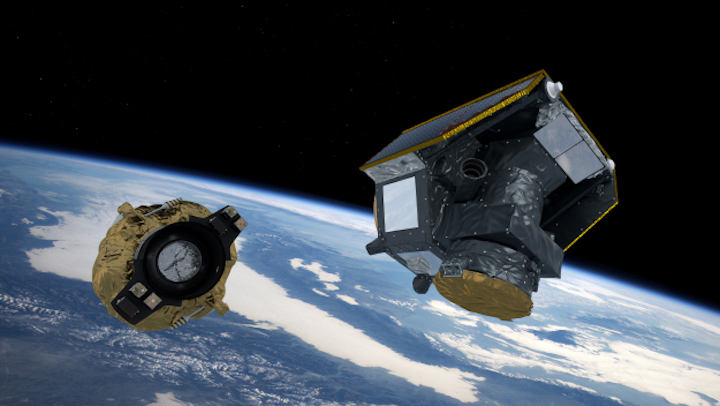
Cheops, ESA’s ‘Characterising Exoplanet Satellite’, is scheduled to be launched on a Soyuz-Fregat rocket from Europe’s Spaceport in Kourou, French Guiana, at 09:54 CET on 17 December 2019. Representatives of traditional and social media are invited to apply for accreditation to follow the launch live from ESA’s European Space Astronomy Centre (ESAC) near Madrid, Spain.
Cheops is ESA’s first mission dedicated to the study of extrasolar planets, or exoplanets. It is a partnership between ESA and Switzerland, with a dedicated consortium led by the University of Bern, and with important contributions from 10 other ESA Member States.
The prime contractor for the design and construction of the spacecraft is Airbus Defence and Space in Spain.
The mission will observe bright stars that are already known to host planets, measuring minuscule brightness changes due to the planet’s transit across the star’s disc.
Cheops will target stars hosting planets in the Earth- to Neptune-size range, yielding precise measurements of the planet sizes. This, together with independent information about the planet masses, will allow scientists to determine their density, enabling a first-step characterisation of these extrasolar worlds. A planet’s density provides vital clues about its composition and structure, indicating for example if it is predominantly rocky or gassy, or perhaps harbours significant oceans.
Unlike previous exoplanet satellites, such as the CNES-led Corot or NASA’s Kepler and TESS missions, Cheops is not a ‘discovery machine’ but rather a follow-up mission, focusing on individual stars that are already known to host one or more planets. It will also identify the best candidates for detailed study by future observatories.
The mission paves the way for the next generation of ESA’s exoplanet satellites – Plato and Ariel – planned for the next decade. Together, these missions will keep the European scientific community at the forefront of exoplanet research and will build on answering the fundamental question: what are the conditions for planet formation and the emergence of life in the Universe?
Cheops will lift off as a secondary passenger, hitching a ride on the Soyuz-Fregat that will deliver the first satellite of the Italian space agency ASI’s Cosmo-SkyMed Second Generation constellation into space. The launcher will also carry three ‘CubeSats’, small satellites based on standardised 10 cm cubic units, including ESA’s OPS-SAT – the world’s first free-for-use, in-orbit testbed for new software, applications and techniques in satellite control.
Experts will present the mission, its technical challenges and scientific goals during a dedicated programme for media at ESAC, which will include viewing the webcast from the launch site in Kourou.

Following completion of propulsion module leak tests at Europe's Spaceport in Kourou, French Guyana, the CHEOPS satellite is being readied to move from the High Bay Facility of S5C to the S5A building, where propellant fuelling will take place.
Provisional schedule at ESA’s ESAC astronomy centre, 17 December
(all times in CET)
08:30 Doors open
09:15 Programme begins
Scientists and mission operations experts present the mission, with live transmissions from Kourou including the moment of liftoff at 09:54 CET. This will be followed by Q&A sessions and individual interview opportunities ahead of the Cheops separation, expected around 12:20, and announcement of acquisition of signal from the Mission Operations Centre located at INTA, in Torrejón de Ardoz, Spain.
14:00 End of event – media invited to join team lunch with representatives of ESA, industry and the scientific community.
Speakers include:
Markus Kissler-Patig, ESA Head of Science Operations
Francesco Ratti, ESA Cheops instrument engineer
Ana Heras, ESA Plato project scientist
Davide Gandolfi, Cheops Science Team member, University of Torino (Italy)
Laetitia Delrez, Cheops Science Team member, University of Cambridge (UK) and University of Liège (Belgium)
Isabel Rebollido, Principal investigator of a Cheops Guest Observer proposal, Universidad Autónoma de Madrid (Spain)
How to apply
Media with valid press credentials should register by 15 December at:
https://www.esa.int/Contact/mediaregistration
Social media should register by 15 December at the same link as above.
Note that there is no dedicated social media event; those attending with social media accreditation will have the same access to the event as traditional/online news media. Social media participants should check here that they meet the eligibility criteria before applying.
Follow online
Webstreaming
ESA Web TV will cover the launch live from 09:30 CET at esawebtv.esa.int
Social media
For live updates throughout the launch period, follow @ESA_CHEOPS and @esascience on Twitter. The official hashtag is #cheops
Quelle: ESA
----
Update: 14.12.2019
.
Watch Cheops launch live

Tune in to ESA Web TV from 08:30 GMT (09:30 CET) Tuesday 17 December to watch ESA’s exoplanet mission soar into space on a Soyuz-Fregat rocket from Europe’s Spaceport in Kourou, French Guiana.
Cheops, the Characterising Exoplanet Satellite, is scheduled for liftoff at 08:54 GMT (09:54 CET) on its exciting mission to study planets orbiting stars other than the Sun. It is ESA’s first mission dedicated to the study of exoplanets.
Cheops will observe bright stars that are already known to host planets, measuring minuscule brightness changes due to the planet’s transit across the star’s disc. The mission will target Earth- to Neptune-sized planets and will provide information about the character of the planets: that is, if they are rocky, gassy, icy or perhaps harbour oceans. This is a critical step in understanding the nature of planets beyond our own Solar System.
Cheops shares the ride into space with the Italian space agency’s Cosmo-SkyMed Second Generation satellite and three CubeSats: ESA’s OPS-SAT and the French space agency’s CNES's EYE-SAT and ANGELS satellites.
Cheops is scheduled to separate from the upper stage at 11:19 GMT (12:19 CET). The first opportunity for acquisition of signal is expected some 30-40 minutes later, and will be announced from the Mission Operations Centre located at INTA, Spain.

ESA TV Programme live from Kourou (all times CET)
Watch live via ESA Web TV 09:30 – 15:00
Key moments:
09:54 – Launch
10:17 – Separation of Cosmo-SkyMed
12:19 – Separation of Cheops
14:05 – Separation of OPS-SAT
14:11 – All CubeSats separated
14:15 – Official speeches
Around Cheops separation, commentary will be provided in English by ESA’s project scientist Kate Isaak, and in French by the Cheops consortium principal investigator Willy Benz.

Follow online
Join the conversation online with the hashtag #Cheops.
For live updates follow @ESA_Cheops and @esascience.
Twitter coverage will also include insights from ESA’s European launch media event hosted at ESA’s European Space Astronomy Centre, ESAC, near Madrid, Spain.
Press release
A press release will be issued following the separation of all spacecraft and CubeSats.
Cheops is a partnership between ESA and Switzerland, with important contribution from 10 other ESA Member States.
OPS-SAT is an ESA CubeSat. It was developed under the management of ESA in partnership with the Graz University of Technology and partners in Austria, Poland, Germany and Denmark.
Quelle: ESA
----
Update: 15.12.2019
.
Sandbox satellite to test operations innovations in space
This coming Tuesday, ESA is launching the most powerful flight computer ever flown in space – inside a satellite smaller than a shoebox. The OPS-SAT nanosatellite will be the world’s first orbiting software laboratory, available to test novel methods of operating missions in actual space conditions.
OPS-SAT is ESA’s latest technology CubeSat – a small satellite based on standardised 10 cm boxes, much cheaper and quicker to build than traditional missions.
This mission is a ‘3-unit’ CubeSat, built up from three such boxes – but it is extremely capable despite its small size, equipped with an Earth-observing camera, a GPS sensor and startracker for navigation, reaction wheels for positioning, radio antennas and an optical data receiver and retro-reflectors, as well as a very powerful processor with 8 GB of mass memory.

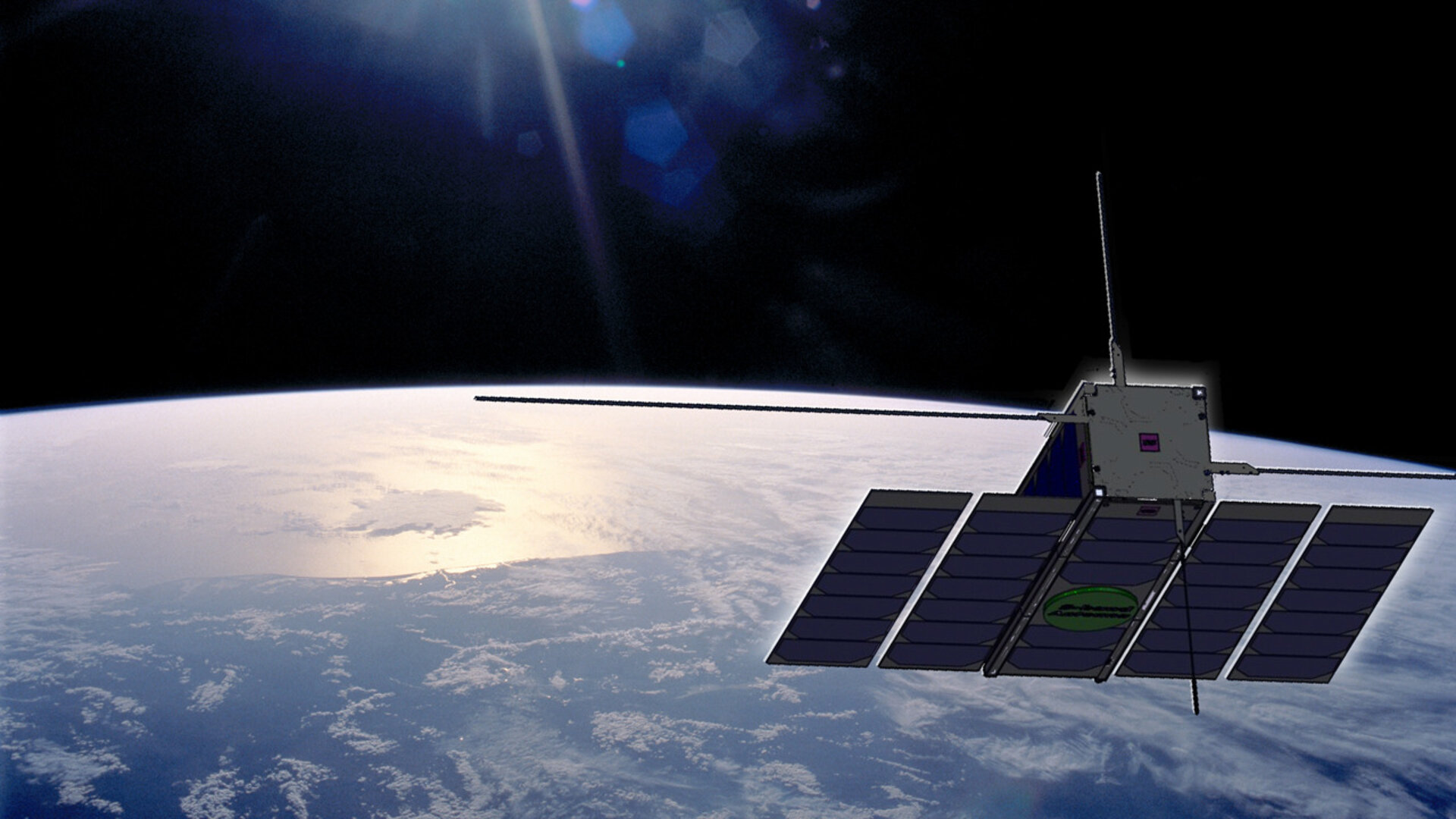
Access the video
“Harnessing more flight computing power than any previous ESA spacecraft, OPS-SAT will be an inflight testbed for all kinds of promising new operational software, tools and techniques,” explains OPS-SAT mission manager David Evans.
“This low-cost mission works just like an extremely complex full-sized ESA satellite in terms of its ground interfaces. This will allow research teams from companies, research institutes or even school computer clubs to gain early space heritage for new technologies, demonstrating new ways of running space missions into the 2020s, when the overall population of satellites in orbit is set to grow exponentially.

“Two key elements of its design are flexibility and safety; OPS-SAT has a separate onboard computer ready to take over as needed if any experimental software goes wrong. The ground can then rapidly recover. The experiments will be run on a dedicated Linux-run payload computer – including powerful chips known as fully programmable gate arrays, or FPGAs which experimenters can reconfigure in orbit to perform complex tasks.”
OPS-SAT will be flying as an auxiliary passenger on Arianespace’s Soyuz flight from French Guiana at 09:54 CET (08:54 UTC, 05:54 local time) on 17 December, along with Italy’s COSMO-SkyMed Earth-observing satellite and ESA’s Cheops exoplanet-tracker, plus several other nanosatellites.

More than 130 teams have already expressed interest in making use of OPS-SAT. In another first for ESA, successful applicants will be given direct access to the CubeSat via the internet.
“Space is changing rapidly, and the way mission control works is changing too,” adds Rolf Densing, ESA’s Director of Operations. “Companies are planning hundreds or even thousands of satellites to accomplish a given mission, in the shape of new mega-constellations planned for low orbits. Individual satellites are going to have to get smarter and more autonomous.

“Accordingly, OPS-SAT experiments cover topics like AI and autonomous planning, fault detection and recognition – allowing satellites to recognise and self-correct errors – as well as new data compression and signal encryption techniques.”
OPS-SAT will also try out optical communications for cryptography experiments and a ‘spectrum analyser in the sky’ experiment for radio signal monitoring.

Experimental software will first be run on OPS-SAT’s ‘flatsat’ – a functional replica of the CubeSat – before being uploaded to orbit.
David Evans notes that actually operating their software in orbit will make all the difference to researchers: “Software does not operate in isolation but in combination with all the different mission systems, in the very different conditions of space – including weightlessness, vacuum, temperature extremes, cosmic ray impacts and occurrences of plasma.
“As space professionals know, it is impossible to verify your new application will work correctly in its target environment unless you fly it. So OPS-SAT is built to accelerate the innovation cycle and break down barriers to space, giving experimenters rapid access to space heritage that might otherwise take decades to gather.”

OPS-SAT was built for ESA by a consortium composed of partners from Austria, Poland, Germany and Demark led by TU Graz and Unitel IT Innovationen in Austria, supported through the FLY element of ESA’s General Support Technology Programme (GSTP), readying promising technologies for space.
Quelle: ESA
----
Update: 17.12.2019
.
Europe postpones launch of planet-studying mission
European space officials have postponed the launch of a three-year mission to study planets in other solar systems shortly before it was due to blast off
European space officials on Tuesday postponed the launch of a three-year mission to study planets in other solar systems less than an hour before it was due to blast off.
The European Space Agency announced that the launch from Kourou, French Guiana, of the Characterising ExOPlanets Satellite, or CHEOPS, mission, would be delayed by at least a day.
ESA director of science Guenther Hasinger wrote on Twitter that “a software error in the Fregat upper stage” of the Soyuz rocket was responsible for the postponement.
“With this complex mission we will not take any risks," he added, advising people to “keep fingers crossed for tomorrow” at the same time.
The mission will focus on 100 of the more than 4,000 extrasolar planets discovered so far, to determine in part whether there’s a possibility of an Earth-like planet capable of sustaining life, Swiss astronomer and Nobel Prize winner Didier Queloz told The Associated Press.
“We are one planetary system among many,” he said. “It’s all about our place in the universe and trying to understand it.”
A space telescope will analyze the exoplanets’ densities and radii and determine whether they have atmospheres, Queloz said.
“We know nothing, except that they are there,” he said.
Once in place, the telescope will focus on bright stars to determine the size of exoplanets as they pass in front of their host star.
Quelle: abcNews
+++
Flight VS23: Soyuz – COSMO-SkyMed SG / CHEOPS / OPS-SAT / EyeSat / ANGELS: Launch delay
During final countdown operations for Flight VS23, the Soyuz launcher’s automated sequence was interrupted at 1 hour 25 minutes before liftoff.
As a result, the launch of the COSMO-SkyMed Second Generation, CHEOPS, OPS-SAT, EyeSat, ANGELS satellites – originally scheduled for December 17 – has been postponed.
The Soyuz launcher and its satellite payloads were placed in a fully safe standby mode.
The new target launch date will be announced as soon as possible.
Quelle: arianespace
----
Update: 18.12.2019 / 10.40 MEZ
.
Flight VS23: Launch rescheduled to December 18

Following an outage that postponed Soyuz Flight VS23 at the Spaceport in French Guiana, replacement operations are underway for the faulty equipment.
The new launch timing is Wednesday, December 18, 2019 at exactly 08:54:20 Universal Time (UTC). A new technical review before fueling of the launch vehicle will occur at H0-5h (five hours prior to liftoff).
The launch vehicle is in a safe mode with its satellite payloads: COSMO-SkyMed Second Generation, CHEOPS, OPS-SAT, EyeSat and ANGELS.

Launch window for Flight VS23 (with liftoff exactly at):
- 03:54:20 a.m., in Washington, D.C.
- 05:54:20 a.m., in Kourou, French Guiana
- 08:54:20 Universal Time (UTC)
- 09:54:20 a.m., in Paris
- 09:54:20 a.m., in Rome
- 11:54:20 m., in Moscow
Quelle: arianespace
----











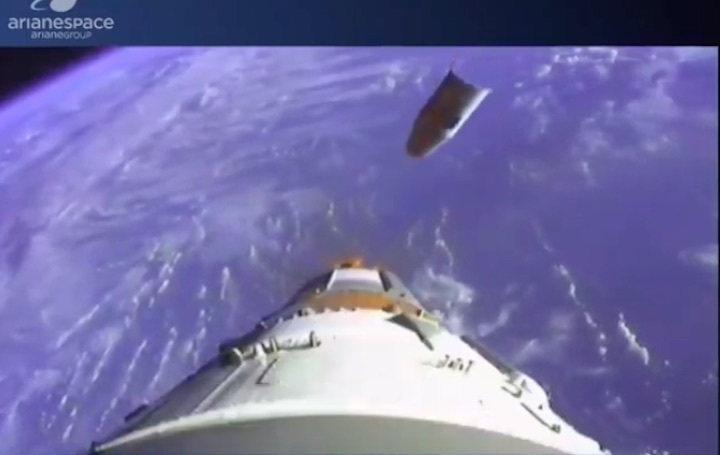









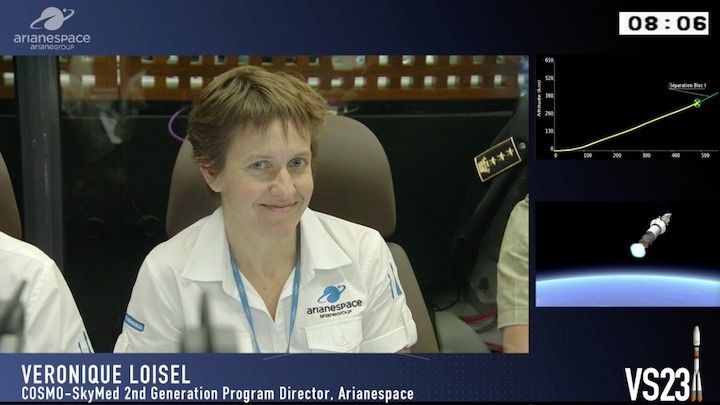
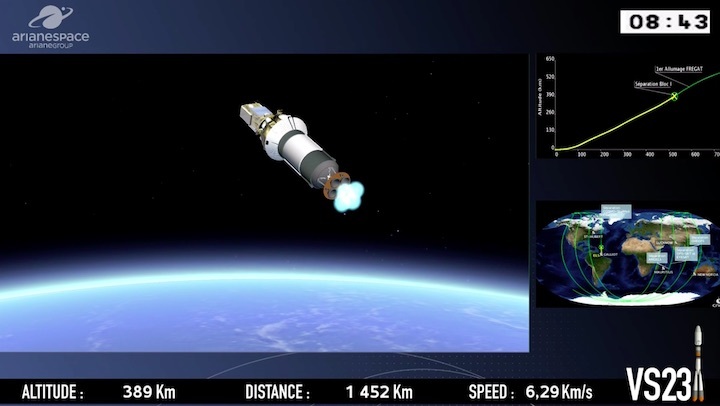


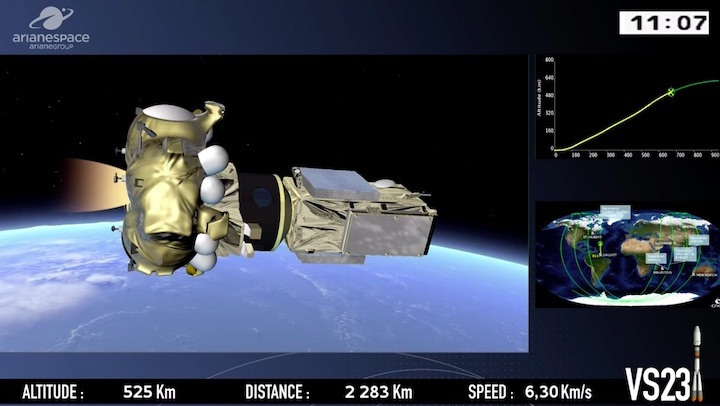


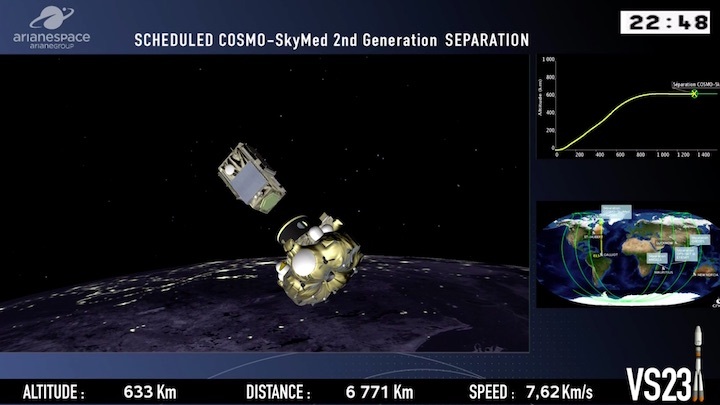

Quelle: arianespace
+++
Update: 20.00 MEZ

Quelle: ESA





